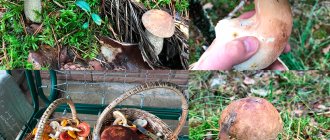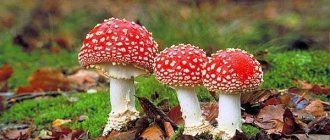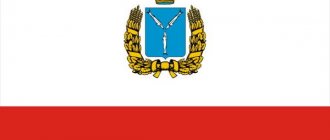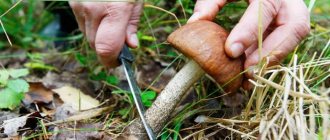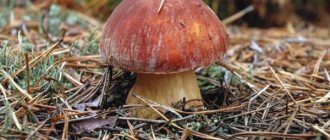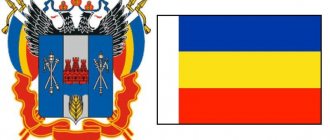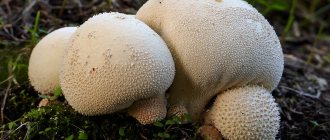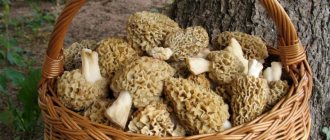The city of Tambov is surrounded by mixed forests on all sides, occupying an area of more than 400 thousand hectares. Therefore, in this region of the country there are many mushroom places where mushroom pickers and lovers of quiet hunting go. With the onset of warm weather, not only mushroom pickers go to the forest, but also simply lovers of nature, forest silence and fresh air. The 2022 mushroom season will certainly not be an exception, and people will bring baskets full of delicious mushrooms home from the forest. Where there are mushroom places in the Tambov region and where to go to get them will be described in the article.
Mushrooms area
A wide variety of mushrooms grow in mixed forests. Among them are many edible, but there are also poisonous ones. In order not to unknowingly pick up a poisonous “gift,” a mushroom hunting novice needs to study the mushrooms in advance, look at the photographs and determine what to be wary of.
Flag and coat of arms of the Tambov region
The most common mushrooms in the Tambov region:
- boletus;
- honey mushrooms;
- boletus;
- boletus;
- white;
- milk mushrooms;
- chanterelles;
- boletus.
There are several general conditions that determine the growth of mushrooms in the vicinity of Tambov. These conditions are typical for all areas of the region, and you need to pay attention to them when going on a “silent hunt”:
- Edible mushrooms prefer lowland areas - there is more moisture there. They are also found on hills and hillocks, but only if the forest is dense and blocks some of the sun's rays, thereby preventing the earth from drying out completely.
- Fungi often grow along power lines. This feature is caused by the fact that trees near power lines are often pruned to avoid contact of branches with wires. And this suits mushrooms perfectly.
- In swampy areas there are few edible mushrooms.
- Dry summers directly lead to a decrease in mushroom yield. But excessive rain does not harm so much - mushrooms stop growing only in sparse, “bald” forests.
Edible
In the Tambov region there are about 180 varieties of edible mushrooms, but most of them belong to the groups described below. The most numerous groups are russula and milk mushrooms. Different representatives of these species differ in color and shape, but not in their qualities.
Porcini
White mushrooms
Everyone knows the porcini mushroom - at least from the pages of a biology textbook. The cap comes in different shades of brown, the stem is thick and barrel-like.
Much of it is hidden underground. In oak forests you can come across boletus - this is a white variety, but with a dark brown cap.
Green moss
Mokhoviki
Moss mushrooms, or Polish mushrooms, are one of the most common mushrooms. They are found almost everywhere, growing both in moss and in old leaves, and sometimes even in tall grass. They are vaguely similar to white ones, but the cap is darker and the leg is yellow-red.
boletus
boletus
Birch groves are rich in these mushrooms, but they are also found in mixed forests. The main way to identify them is the characteristic texture of the stem, consisting of dark gray or black vertical marks. The hat is beige-brown, in different shades.
Boletus
Boletuses differ from boletuses in the color of their cap - it is bright orange. The leg is very similar, but the design consists of dots rather than dashes. Typically, boletuses are found exactly where their name suggests - in aspen groves.
Boletus
Ryzhik
Saffron milk caps
Mushroom pickers love to talk about the taste of saffron milk caps. And for good reason - they are ideal in pickled and salted forms. Ryzhiki belong to the “highest category” mushrooms, along with porcini and boletus.
Honey mushrooms
Honey mushrooms
Mostly autumn honey mushrooms grow around Tambov, but there are also summer ones. The latter are a little brighter in color and not so “shaggy”. Otherwise, the mushrooms look the same - they grow in “families” on old stumps, rotten and rotting wood. If it seems that honey mushrooms are growing from the ground, it is actually the roots of the tree that have come very close to the surface.
Chanterelles
Chanterelles
Bright yellow, sometimes orange - these summer mushrooms grow in large clearings, forming a ring or circle. It is impossible to confuse chanterelles with any other varieties, including poisonous ones, due to their specific appearance.
Milk mushrooms
White lamellar mushrooms growing in the ground. It takes a long time to wash them of sand, but their taste is one of the best. Some types of milk mushrooms produce a bitter “milk” and therefore need to be soaked. Others can be cooked immediately.
Real milk mushroom
Russula food
Russula
A large group of lamellar mushrooms, differing in the color of the cap. The stem and inner flesh are always white - a different color indicates that this is not a russula, but an inedible mushroom.
The film is easily removed from the cap. The most common are green, red and yellow russula.
Real morel
Morels
Spring mushrooms that are almost impossible to find later than June. The hat is “wrinkled”, reminiscent of very curly hair. Due to their specific appearance, they are unlike other mushrooms - only in lines, but there are practically no such mushrooms in the Tambov region.
Rare mushrooms
Rare edible species of the Tambov region include:
- boletus (common in certain areas, rare in other areas);
- reshetniki (similar to flywheels, but the cap is lighter and cracks like a “mesh” - hence the name);
- poddubnik (not to be confused with oak mushrooms - poddubnik is more like a light brown milk mushroom, has a lamellar cap);
- gray and green rows (the latter are also called “greenfinches” for their completely lemon color, including the pulp);
- forest champignons (they look almost like store-bought ones, but the cap is covered with a yellow film that can be easily removed);
- valui (there are good and bad, it’s better not for beginners to collect);
- puffballs (delicious spherical white mushrooms, but with age they turn yellow and become inedible).
dourman83
muhunteroom
paconad
mushroomphotos
Mushrooms in mid-autumn
Walking through the autumn forest, when the sun is warm and the leaves rustle under your feet, you can see mushrooms at almost every step. October is an excellent time for mushrooms : cool nights and foggy mornings, which has a very beneficial effect on the quality of mushrooms. Mushrooms collected in October will be better stored in winter than those collected earlier.
In October, you need to look for mushrooms in the forest, because they predominate in the clearings in September, and October mushrooms grow under trees, in forest thickets and on stumps. So, what mushrooms grow in October:
- Honey mushrooms.
- Saffron milk caps.
- Bitters.
- Greenbacks.
- Boletus mushrooms.
- White.
- Oyster mushrooms.
- Talkers.
- Garlic mushrooms.
- The rows are purple.
- Volnushki.
- Chanterelles.
- Late boletus
- Black milk mushrooms.
Judging by the list, this will be a good harvest, but remember that you need to go for October mushrooms before the first frost , while the weather is favorable. Each type is tasty in its own way, and you can prepare a wide variety of dishes and preparations. But in order not to collect toadstools in October, you need to study each species in detail.
Boletus, boletus and oyster mushrooms
Boletus mushrooms are edible mushrooms that do not necessarily grow under birch trees. They can be found in deciduous forests absolutely anywhere. Thus, mushroom pickers often collect boletus mushrooms on the edges and hillocks. The hat is dark brown, in the shape of a semicircle. Inside there is white pulp, which immediately darkens when cut. A young mushroom is elastic and dense, an old one is watery and fibrous, and the stem becomes tough and inedible. Therefore, it is worth collecting only young mushrooms.
For the winter, boletus can be used to make excellent canned food or simply dry it. Just imagine soup with dried boletus on a cold winter evening. Once you inhale the aroma of this dish, you are already transported to the autumn forest.
The next type of mushroom that is harvested in October is boletus or white mushroom. It is considered royal among mushroom pickers because it has an amazing taste and aroma. Boletus grows in a pine or spruce forest. The cap is dark brown to purple. The pulp is white and very dense, which does not change color when cut. A basket of porcini mushrooms offers a wide variety of dishes. Pickles, fried and boiled boletus, as well as dried for the winter. This is a very valuable and expensive mushroom, so if you collect a basket of boletus mushrooms, you can consider yourself lucky.
Varieties of mushrooms in the Leningrad region
Oyster mushroom is an unpretentious mushroom that is not afraid of frost. These mushrooms can be collected at the end of October, and in some regions even in December. Habitat: stumps, aspens, oaks, birches or poplars. So, while wandering through the forest in search of tasty mushrooms, pay attention to the stumps where young oyster mushrooms may be hiding. The shape of the oyster mushroom resembles an ear and belongs to the oyster mushrooms.
A young mushroom has a convex cap with curved edges, but adult mushrooms have smooth edges. The stems of the mushroom are dense and slightly curved down. The color is grayish, even ashy. You can prepare a lot of dishes from oyster mushrooms. You can marinate them, or you can fry them with onions, and they are also great when salted.
True connoisseurs of this mushroom try to grow oyster mushrooms at home. They simply place the bags of spores in the cellar and - voila! - fresh mushrooms all winter.
Honey mushrooms and saffron milk caps
Lovers of mushrooms can find them on damaged trees; this is a favorite habitat for mushrooms. Often these are birch or aspen trees. Honey mushrooms are less common on coniferous trees. The shape of the fungus cap resembles a ball, the stem is thin and dense, up to 18 centimeters long. Colors range from cream to yellow, but sometimes have a red tint. Honey mushrooms can be either pickled for the winter, dried or fried. Mushrooms are also very tasty and simply pickled.
Mushroom pickers of Kuban: picking mushrooms in the spring-summer season
The next type of October mushrooms are saffron milk caps. It is simply impossible to miss them in the forest. The bright red color and the convex cap, wrapped at the edges, immediately gives the mushroom away, no matter where it is hiding. Habitat: pine forests. The taste of the mushroom is not inferior to white or any other. And when preserved, it retains its bright color. In many countries, sauces are made from camelina and added to a variety of dishes, and camelina oil is especially popular among gourmets. This highly aromatic product is ideal for dressing salads or cooking.
Talkers and Garlics
Talkers got their name because of the hats that look like a loudspeaker. Lives in temperate climates. The govorushka tastes sweet with spicy notes. The leg is not eaten, but the cap is very tasty either marinated, fried or salted. You can identify a talker not only by the shape of its cap, but also by its floral smell.
Walking through the October forest, enjoying the last warm days, pay attention to the stumps. This is where you can find the garlic mushroom. It got its name because of its garlicky smell. The mushroom has a small convex cap and a thin stalk. The color comes in both brown and red. Usually these mushrooms are dried and used as a seasoning.
Blues and waves
Purple row or cyanosis is an excellent mushroom that is eaten fried, salted, or pickled. The color of the cap is purple in a young mushroom, and with age it becomes dark purple. The diameter of the cap reaches 15 centimeters, and the cylindrical leg reaches all 8 centimeters. The taste has a fruity aroma, and when raw it is sweet.
If you want to tinker a little with mushrooms, but get a worthy reward in the form of an amazing taste, go to the birch forests for volnushki. They require a lot of effort when processing, but they have a very rich taste no matter how they are prepared. You can recognize the mushroom by its convex pinkish cap up to 12 centimeters in diameter, which is framed by a fringe. The leg reaches 6 centimeters. Volnushki can be salted or fried; they will amaze your guests with an unforgettable taste. The work will not be in vain. For example, a very tasty dish is baked trumpets with rice and vegetables.
Where and when do honey mushrooms and other mushrooms grow in the Krasnodar region
Chanterelles and greenflies
A popular species among mushroom pickers is chanterelles. Firstly, they have a refined taste, and secondly, these mushrooms are not wormy. A mushroom of bright rich yellow color with curved wavy edges of the cap. The habitat of chanterelles is coniferous forests. They are often eaten fried with potatoes. And their unforgettable aroma transports you to the forest path of a coniferous forest.
Who would have thought that edible green mushrooms exist? Yes, believe me, there is. Zelenukha or green row is a mushroom of rich green color that does not change even after processing. Habitat: pine forests. Their flat caps peek through the pine needles. The smell is nutty, and they taste very meaty. Just remember, you need to consume green flowers in moderation, otherwise you can get poisoned.
Unusual boletus and black milk mushrooms
Boletus mushrooms are not for everyone. They live in pine or mixed forests and have a convex cap. Mushrooms grow on the edges of the forest in groups. Often, adult mushrooms are affected by worms, so you should only look for young fungi. A distinctive characteristic is that it is highly oily, so it is ideal for frying, boiling and pickling.
From time immemorial in Rus', black milk mushrooms were considered an excellent appetizer for a feast. But in order to use them in food, you need to tinker. The harvest is soaked for a long time, and only then pickled or salted. Milk mushrooms are also popular among mushroom pickers because they are not wormy due to their pungent juice. Young black milk mushrooms have an olive tint, and with age they become dark brown. The thickness of the stem reaches 8 centimeters, and the cap is convex with rolled edges.
Inedible
Inedible mushrooms are “those who like to camouflage.” They look edible in appearance, but have an unpleasant taste. Many inedible species contain a weak poison that has almost no effect on humans, while others are not poisonous at all. But due to their sharply repulsive taste, they are not collected.
Green row
Rows
With the exception of green and gray (edible), most of the rows in Tambov and the region are conditionally edible.
But there are also inedible species that are very similar to those that can be eaten. Even many experienced mushroom pickers do not take them, and they are not recommended for beginners at all.
But “greenfinches” and gray rows can be taken with confidence - they do not have inedible doubles.
Volnushka pink
Volnushki
The situation is the same for the volnushki as for the rows. There are edible species, but it is quite difficult to distinguish them, so considerable experience in “silent hunting” is required.
Most varieties of volushki in the Tambov region have an unpleasant taste - for some it disappears after soaking, for others it remains. There are also poisonous waves, but these are practically never found near Tambov.
Milkers
The shape and texture of the caps look like saffron milk caps, but differ in beetroot color. When damaged, they release a burning “milk”, which is where they got their name.
After a long soak in salt water, they are edible and even quite tasty, especially when pickled. But most mushroom pickers do not collect them, since laticifers are much less common than many edible species.
Common milkweed
Gorchak or gall mushroom
Gall
They are similar to boletus mushrooms and grow in the same places. They are distinguished by a yellowish leg, while in boletus it is white or light gray. There is no poison in gall mushrooms, but the bitter taste is extremely unpleasant and “infectious” for good varieties.
Satanic
They vaguely resemble white ones, but their putrid smell gives them away. The taste is also very repulsive - burning and unpleasant. A weak poison is practically harmless to humans, but if a satanic “specimen” gets into a dish, the taste will be hopelessly spoiled.
Satanic mushroom
Inedible and poisonous varieties
Tambov lands are rich not only in good mushrooms. Many inedible varieties grow here, including some highly poisonous mushrooms.
False honey mushrooms
Edible honey mushrooms can be confused with sulfur-yellow and red-brown honey mushrooms. Poisonous mushrooms are identified by the absence of a mushroom ring on the stem. Also, the smell of the fruits of the sulfur-yellow false honey mushroom does not even remotely resemble the pleasant mushroom aroma of real honey mushrooms. Poisonous sulfur-yellow mushrooms stink rather than smell.
And in the red-brown honey mushroom, the color of the fruit is very bright, catchy, very different from the pastel, yellow-brown color of edible honey mushrooms.
Satanic mushroom
The natural counterpart of boletus mushrooms is the satanic mushroom. It differs from the noble Boletovs in the following features:
- light color of the cap, expressed in shades of gray, white, olive;
- carmine red leg;
- mesh on the leg;
- tubular layer that turns blue when pressed;
- flesh that turns red or blue at the break with an unpleasant odor.
The fruits of the satanic mushroom contain muscarine, a potent poison. But its concentration is small compared to fly agarics. In some European countries, the satanic mushroom is eaten after certain complex processing.
Toadstool pale
The most dangerous false mushroom is toadstool. It can be confused with many edible mushrooms, whose colors are expressed in white, gray and greenish tones.
You can distinguish a toadstool by the following characteristics:
- sac-like volva at the bottom of the leg (sometimes hidden in the soil);
- membranous ring on the stem;
- white plates on the back of the cap that do not change color during aging or due to mechanical damage.
Attention!
Even the spore powder of toadstool is extremely toxic. Therefore, you should never take this mushroom, even out of curiosity.
Fly agarics
Such different fly agarics grow in the Tambov forests. In addition to the common red ones, you can also find white, yellow and bronze fly agarics here. All of them are poisonous and dangerous. Mushrooms are distinguished by the presence of a ring on the stalk and a flaky white coating that covers the entire body of the fly agaric.
Mushrooms of this type have hallucinogenic properties. The legislation of the Russian Federation prohibits the use of fly agaric fruits for the purpose of obtaining narcotic drugs from them.
Tambov forests abound in mushrooms. Each species has its own time and place of fruiting. But even knowing these facts, it is better to go into the forest with an experienced mushroom picker, since among the edible species there are poisonous decoys.
Poisonous
You need to be especially careful with poisonous varieties. The mushroom picker must be able to recognize them so as not to jeopardize his health and life. Some poisons are so strong that death if ingested is almost inevitable.
Expert opinion
Melnikov Vladimir Mikhailovich
Knows 1000 ways to cook, pickle and marinate any types of mushrooms
The most common and dangerous types of poisonous mushrooms are described below. But do not forget about the main rule - any mushroom whose appearance is in doubt should be avoided.
Death cap
Pale toadstools
The toadstool is characterized by a whitish-green color, and its cap is often (but not always) covered with flakes, like a fly agaric. The shape of the cap can be different - from cone-shaped to completely open. On the leg there is a “skirt” made of film.
This is a very poisonous mushroom that “infects” the entire basket and is harmful to health even through touch. Although death occurs only when ingested. Toadstool can be confused with green russula or light-colored types of rows, so if there is the slightest doubt, the mushroom should be avoided.
Fly agarics
Fly agarics
A large group of poisonous mushrooms that differ from each other in size, color, and cap shape. Most of them are covered with scales. The stem, as a rule, grows from an “egg”, the remains of which can be seen even in adult mushrooms.
It is impossible to confuse fly agaric with a good mushroom - its appearance is too specific.
False honey fungus
False honey mushrooms
The poisonous “version” seems similar to edible honey mushrooms, but only at first glance. Upon closer inspection, you will notice a more aggressive red color than ordinary honey mushrooms. The plates under the cap are also brighter in color - they are reddish-green in poisonous ones and beige in edible ones.
Cobwebs
Very poisonous, but completely unlike any of the edible varieties found in the Tambov region. They are small and thin-legged, with unremarkable color - shades ranging from dark gray to brown. The cobweb can only resemble rotten honey fungus. But since no one will pick up rotten honey fungus, the spider web cannot get into the basket.
Patouillard fiber
Fiber racks
Fiberworts, or inocybe, vaguely resemble honey mushrooms. But in the center of the cap they have an expressive “elevation”, and the color is most often an order of magnitude paler. There are also reddish fibers. They are easily identified by the smell of pepper or medical alcohol. The mushroom aroma is completely absent.
Reddish talker
Talkers
Similar to rows, but much more dangerous. Some types of talkers are simply inedible, while others are deadly poisonous. Shades range from white to pink. Some subspecies can be confused with milk mushrooms, but milk mushrooms have a hole in the middle of the cap, which cannot be said about talkers.
Sosnovsky district
In the north and northwest there are amazingly beautiful forests. They occupy about 50 thousand hectares. The center of the district is the village of Sosnovka. The forest surrounding it is dominated by pine and spruce, but there are deciduous trees. Here, according to the mushroom map, an abundance of porcini mushrooms, saffron milk caps, chanterelles, honey mushrooms, and boletus mushrooms is noted. There are also rare species listed in the Red Book, for example, the satanic mushroom.
Honey mushrooms grow in cleared trees. They feed on organic matter accumulated in stumps. It is important for mushroom pickers to distinguish false honey mushrooms (by the yellow-green plates under the cap): they are poisonous.
You should not take dubious mushrooms into a basket: poisonous species can easily be confused with real ones.
Many mushroom places are located in other districts of the Tambov region: Michurinsky, Bondarsky. A good harvest of mushrooms is collected in the following villages:
- Znamenka, Knyazhevo, Chernitovo, Alkuzhi, Novotomnikovo, Kulevatovo - on the Tsna River (pine forests).
- Chutanovka, Velmozhka, Verkhnee Chuevo, Karaul, Krasivka - on the Vorone River (oak groves).
The main part of the forest plantations is located in the basin of the Voronezh River and its tributary Ilovai.
Mushroom places
You can find mushrooms in every forest of the Tambov region, but the main question is their quantity. To return home with a big harvest, you need to go to one of the following places.
| Place | Area | Peculiarities |
| village Novaya Lyada | Tambovsky | Novaya Lyada is located on the river. Forest Tambov, 10 km from the regional center. Near the village there is a mixed forest - pine and oak interspersed with other deciduous trees. Various mushrooms are collected here, from spring morels to late honey mushrooms. The best period is from July to September |
| With. Tulinovka | Tambovsky | In this village, located 28 km from Tambov, there are many boletus and aspen mushrooms. White ones are common. In autumn there are a lot of saffron milk caps, moss mushrooms, honey mushrooms |
| With. Bald Mountains | Tambovsky | The village is 18 km from Tambov, located on the river. Chelnovaya. Local forests and ravines are rich in boletus and boletus, but other mushrooms are also found. |
| Tambov | The forest belts closest to the regional center are also rich in mushrooms, and they grow here until frost - and sometimes even after. But there are even more people wanting to harvest the harvest than the harvest itself | |
| R. Lyada, b. Lesnoy Tambov | Rasskazovsky | Broad-leaved forests in the vicinity of these rivers are rich in boletus, milk mushrooms and boletus. Particularly noteworthy are the forests, in which there are many oaks and maples, as well as aspen and birch groves |
| village Fur Factory | Rasskazovsky | The oak groves near the village are notable for the abundance of boletus and milk mushrooms |
| R. Kersha, s. Picher | Rasskazovsky | Near these villages and rivers there are some of the richest places in the entire region with morels. They are collected mainly in May |
| village Sosnovka | Sosnovsky | There are many coniferous forests around the village. They contain white mushrooms, boletus, honey mushrooms, saffron milk caps, and chanterelles. A similar picture is observed throughout the area, but the forests around the village are located in the center, and therefore more accessible to mushroom pickers |
| R. Price | In the pine forests along the entire length of the river there are many different mushrooms | |
| R. Crow | All along the river there are oak forests with different mushrooms. There are a lot of white and boletus here | |
| Michurinsky | There are fewer mushrooms in this area than in the locations described above, but they are found throughout the region without exception | |
| Bondarsky | A situation similar to Michurinsky district |
Of course, the list does not include all the mushroom places in the region, but only the most famous ones. Families with “mushroom traditions” always have a group of little-known locations in mind that other people don’t know about.
Rasskazovsky district
Forests are rich in mushrooms
The description of this area concerns not only mushroom glades. Broad-leaved forests grow near the rivers whose names are Lyada and Lesnoy Tambov. Maple and oak are easy to find there. There are isolated oak groves (Fur Factory village), aspen groves, and birch groves. “Mushroom” tourists come here in pursuit of boletus, boletus, and milk mushrooms.
Mushroom picking can be perfectly combined with relaxation on picturesque rivers and lakes (their names are Kersha, Picher). In May, morels appear - the first edible mushrooms.
What is collected by month in spring, summer, autumn
The table shows the time frame for the appearance of different types of mushrooms. Since the climate in the Tambov region is even, without sharp extreme cold in the autumn, many species are found even after the lower limit. This is especially true for summer varieties, the appearance of which is highly dependent on rain. Rainy summers prolong the period of appearance of summer mushrooms.
| Mushrooms | When to collect |
| Morels | April June |
| Raincoats | May – August |
| Chanterelles | June – September (first half) |
| Boletus | June – September |
| Forest champignons | June – September |
| Reshetniki | June – September |
| Butter | June – October |
| Saffron milk caps | July – October |
| Russula | June – October |
| Rows | June – October |
| boletus | June – November (peak period is August and September) |
| White mushrooms | June – November (mostly from August to October) |
| Poddubniki | July – October |
| Milk mushrooms | July (second half) – October |
| Valui | August – October |
| Honey mushrooms | August – November (summers grow from June to August) |
Mushroom picking dates in 2022
Each variety bears fruit differently. In 2022, you should look for certain mushroom species at the following times:
| Species name | Fruiting period |
| Boletus, russula, boletus | early summer – mid-autumn |
| Milk mushrooms | August – first ten days of October |
| Boletus | mid-summer – October |
| Autumn honey mushrooms | end of August – November inclusive |
| Umbrellas | June – end of November |
| Mokhoviki | mid-summer – early autumn |
| Chanterelles | summer - early autumn |
| Volnushki | July – September |
| Ryzhiki, rows | August – October |
It is quite difficult to name the exact timing of fruiting of the mycelium. Productivity largely depends on weather conditions.
